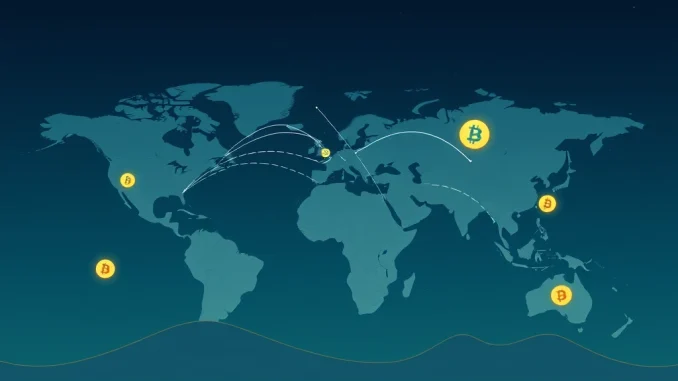
Major news is buzzing in the financial technology world, particularly for those keeping an eye on the intersection of traditional finance and cryptocurrencies. Solid Intel, a source on X (formerly Twitter), reports that global online payments giant Stripe is reportedly in early discussions with banks to explore the potential use of stablecoins for enhancing global payment processing. This isn’t just a minor update; it signals a potentially significant shift in how one of the world’s leading payments companies views the future of cross-border transactions and payments technology.
Why is Stripe Looking at Stablecoin Integration?
Stripe has long been a frontrunner in simplifying online transactions for businesses worldwide. However, traditional global payments still face hurdles like high fees, slow settlement times, and complex currency conversions. Stablecoins, cryptocurrencies designed to maintain a stable value (usually pegged to a fiat currency like the USD), offer potential solutions to these problems. Exploring stablecoin integration could allow Stripe to leverage the benefits of blockchain technology while mitigating the volatility risks associated with cryptocurrencies like Bitcoin or Ethereum.
Here are some key benefits stablecoins could bring to global payments:
- Faster Settlement: Transactions can settle in minutes or seconds, rather than days.
- Lower Costs: Reduced transaction fees, especially for international transfers.
- Increased Accessibility: Potential to reach underserved markets and individuals globally.
- Enhanced Transparency: Transactions recorded on a public or permissioned ledger.
- Simplified Currency Exchange: Using stablecoins pegged to major currencies could streamline cross-border flows.
How Could Stablecoins Reshape Global Payments?
The current landscape of global payments often involves multiple intermediaries, leading to delays and added costs. Imagine a business in the US paying a supplier in Europe. This typically involves SWIFT transfers, correspondent banks, and currency conversion layers, each adding time and expense. Using a stablecoin, like a USD-pegged one, could allow the US business to send value directly to the European supplier’s digital wallet, where it could potentially be held as stablecoins or instantly converted to EUR via a crypto-friendly service.
This potential shift towards crypto payments powered by stablecoins isn’t just theoretical. Other companies are already exploring or implementing similar solutions. For Stripe, integrating stablecoins would mean offering its vast network of businesses a faster, cheaper, and potentially more efficient way to send and receive money internationally. This move could significantly impact the payments technology sector, pushing competitors to explore similar blockchain-based solutions.
What Are the Challenges for Stripe Stablecoin Adoption?
While the benefits are compelling, integrating stablecoins into a massive platform like Stripe comes with significant challenges:

- Regulatory Uncertainty: The regulatory landscape for stablecoins is still evolving globally, posing compliance risks.
- Technical Integration: Building and maintaining the infrastructure to handle stablecoin transactions at scale is complex.
- Bank Collaboration: Working with traditional banks, who may have varying levels of crypto readiness, is crucial but potentially difficult.
- User Education: Businesses and consumers need to understand how stablecoin payments work.
- Interoperability: Choosing which stablecoins and blockchain networks to support requires careful consideration.
Stripe’s reported talks with banks suggest they are actively trying to navigate these challenges, particularly the banking and regulatory aspects, which are critical for widespread adoption.
What Does This Mean for the Future of Crypto Payments?
Stripe exploring stablecoin integration is a strong indicator of the growing acceptance and potential utility of cryptocurrencies, specifically stablecoins, within mainstream finance and commerce. If a company with Stripe’s reach successfully implements stablecoin-based solutions, it could accelerate the adoption of crypto payments globally. It validates the technology’s potential beyond speculative trading and into practical, everyday financial applications.
This development could pave the way for:
- Increased merchant acceptance of stablecoins.
- More seamless cross-border e-commerce.
- Innovation in payments technology from competitors.
- Greater collaboration between traditional financial institutions and crypto companies.
While still in early talks, Stripe’s interest is a powerful signal to the market. It suggests that stablecoins are increasingly being viewed not just as crypto assets, but as a viable technology layer for improving existing financial infrastructure, particularly for complex and costly global transactions.
Conclusion: A Potential Game Changer?
Stripe’s reported exploration into using stablecoins for global payments is a potentially transformative development. By leveraging the speed, cost-efficiency, and global reach of stablecoins, Stripe could significantly enhance its service offerings and address long-standing inefficiencies in cross-border transactions. While challenges remain, particularly regarding regulation and integration, the fact that a company of Stripe’s stature is seriously considering stablecoin integration underscores the growing maturity and potential of crypto payments. This is a story worth following closely, as it could indeed revolutionize how businesses send and receive money around the world.



